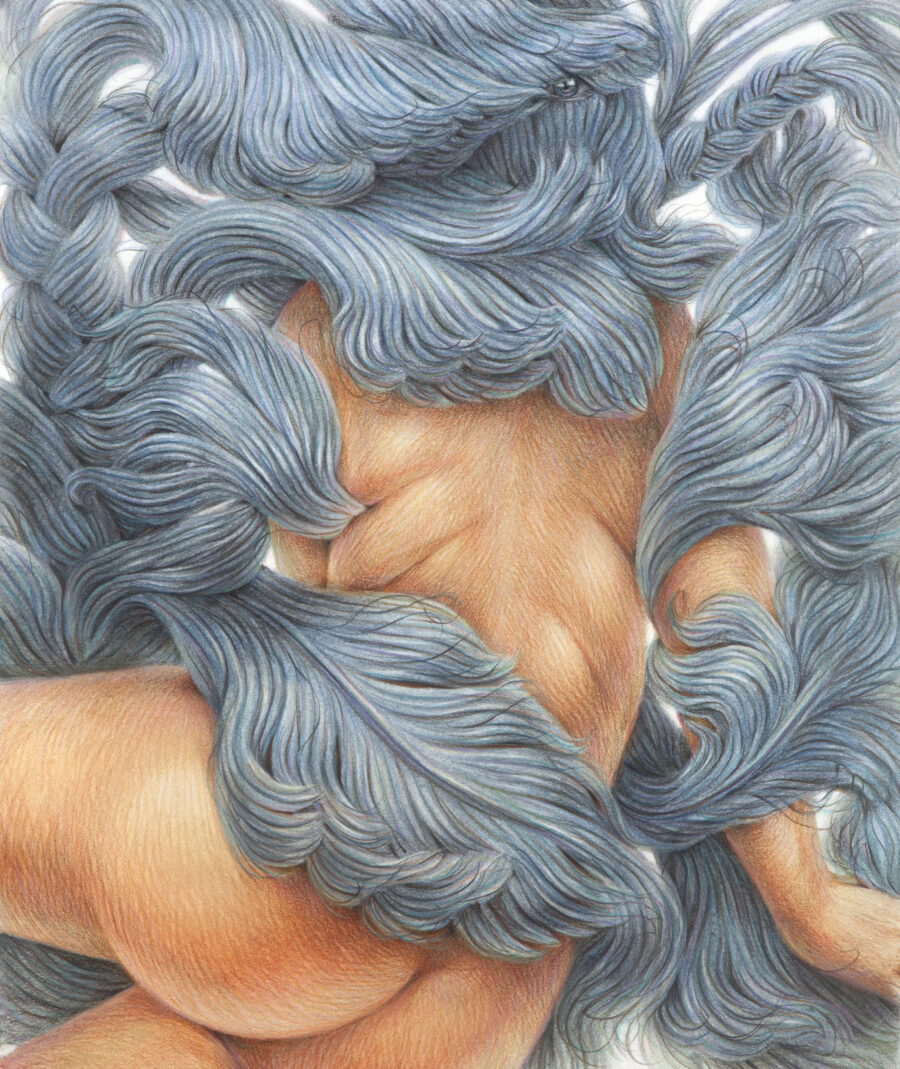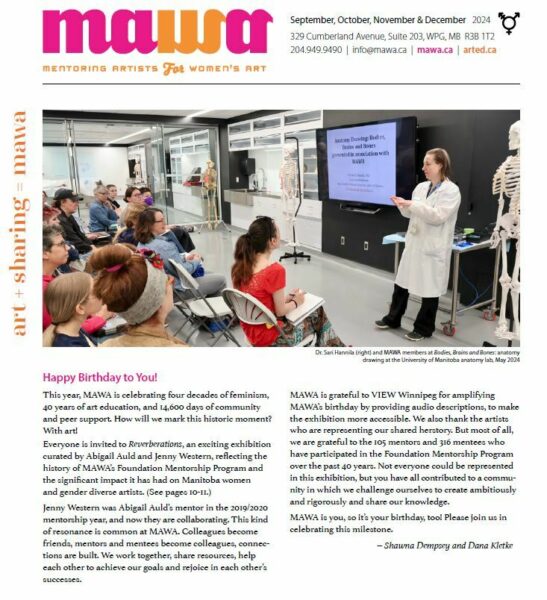
Caption: Winnie Truong, My Best Friend Is Invisible, pencil crayon on paper, 16” x 19”, 2015
“Hair is everything. We wish it wasn’t, so we could actually think about something else occasionally, but it is. It’s a difference between a good day and a bad day. We’re meant to think that it is a symbol of power, that it is a symbol of fertility. Some people are exploited for it and it pays your fucking bills. Hair is everything, Anthony.”[i]
Hair makes me nervous.
This constant, uncomfortable feeling remained subtly in the background until I saw Carissa Baktay’s exhibition Form(er) at Winnipeg’s C2 Centre for Craft in 2021. She exhibited a series of elegant sculptures in which she shaped horsehair into controlled forms using glass. She had full power over something I had continuously cried over.
My obsession with hair started one semester during my undergrad when I lost almost half my hair. At the time I wasn’t sure why, but I just couldn’t stop ripping it out.
Looking at Baktay’s pieces, I was simultaneously mesmerised and disgusted, but I didn’t know if I was disgusted with the work or with myself. Previously, I’d thought my fixation with my hair was irrational and superficial. I had tried to ignore it, but Baktay’s exhibition pushed it to the forefront.
The semester I lost my hair, I scoured the Internet, reading medical websites, blog posts, and watching YouTube videos as a new word seeped into my vocabulary: trichotillomania.
I had a history of depression and anxiety, but a form of OCD was new to me, and I couldn’t look in a mirror for more than a few seconds without crying.
In 2016, the CBC reported that trichotillomania affects roughly 2-5% of the population, the majority being women.[ii] They also stated that the number is likely higher, and that the study didn’t take those with less severe cases into account.
Looking back, it makes sense that my worsening anxiety morphed its way into trichotillomania. It is well documented that hair reflects our mental wellbeing, and more often the deterioration of that wellbeing. Just as the study showed that trichotillomania primarily affects women, the history of hair and wellbeing in our culture is also predominantly in relation to women.
In Sylvia Plath’s The Bell Jar, Esther Greenwood’s shaved head is the final signifier of her declining mental health. Once she arrives at a hospital, a nurse gives her a mirror in which she does not recognize herself. Esther mistakes the mirror for a framed photograph of a stranger, and remarks: “You couldn’t tell whether the person in the picture was a man or a woman, because their hair was shaved off and sprouted in bristly chicken-feather tufts all over their head.”[iii] She goes on to describe her reflection’s bruised face, then breaks the mirror when recognition sets in.
In the fall of 2022, I worked as an intern for the Venice Biennale, and I was once again overcome by the use of hair in art.
Laetitia Ky, one of the artists representing Ivory Coast, exhibited photographs in which she created sculptures out of her own hair. In one photograph, she had turned her hair into a pestle, which she held above the mortar as though preparing a meal. The tool looked heavy in her unwavering arms and it was clear that she, and her hair, were two very strong entities.
Curiosity overtook me, and I began searching for other examples of hair in art. Since few eras handle an obsession as healthily as the Victorians, it was no surprise that they too created intricately detailed hair art. This was no longer a simple lock of hair passed on to a suitor as in the exchanges described by Jane Austen. The Victorians created the floral still life, some pieces framed, others sculpturally contained within a bell jar.
When hair is used as an artistic medium today, its appearance is often jarring. In Winnie Truong’s early drawings, figures are engulfed in their hair. It wraps around their entire body, either as a blanket or as a straitjacket, simultaneously calming and unnerving. These works, rendered in vibrant colours and often featuring intertwined florals, accentuate the importance of hair.
It feels surreal to me to describe hair as calming, since that has not been my own experience with it. Although perhaps it’s inevitable that someone with OCD would be drawn to Truong’s artwork. Wendy Paert writes that Truong’s work “appeals to an excessive, obsessive impulse.”[iv]
I used to consider hair the bane of my existence. I avoided mirrors and was embarrassed to be seen without a hat on. While the hair itself wasn’t suffocating, the anxiety that came from it was. Truong’s drawings feel like recognition, like I’m no longer alone in my obsession with hair and, with that understanding, it feels like the bell jar has been lifted.
During the height of my experience with trichotillomania, I thought there was something wrong with me. I didn’t understand the disorder and thought it embarrassing to think so much about my hair. But hair in our culture contains meaning far beyond the individual. Media is steeped in the messaging of unrealistic beauty standards, including standards for hair. Perhaps as a result, many women artists have been drawn to working with hair in order to understand and reconsider these narratives.
The anxiety that hair can cause isn’t trivial or self-indulgent. Hair can be all-encompassing. In the simplest of terms, hair is the difference between a good day and a bad day.
Lindsay Inglis is an arts writer, researcher and curator from Winnipeg, Manitoba, on Treaty 1 territory. She completed her MA at the University of St. Andrews and her BFA at the University of Manitoba.
[i] Fleabag, Season 2, Episode 5
[ii] Katrina Clarke, “The truth about trichotillomania - the hair pulling disorder.” CBC, 24 November 2016 https://www.cbc.ca/life/wellness/the-truth-about-trichotillomania-the-hair-pulling-disorder-1.3865541
[iii] Sylvia Plath, The Bell Jar. London: Faber and Faber, 1966, p. 168.
[iv] Wendy Paert, “Being Material,” in Material Girls, ed. Jennifer Matotek. London: Black Dog Publishing, 2015, p. 11.

